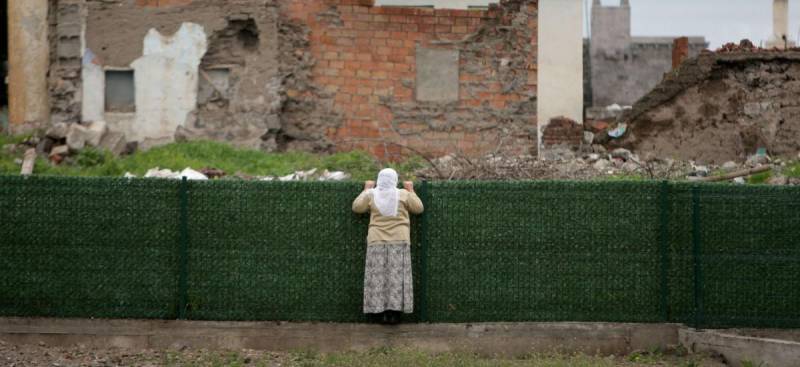My hometown Sur is becoming quieter by the day. Those who leave are either moving away to make a living elsewhere or flee from the authorities; those who remain retreat inside their homes and try to power through this dark period in the district’s history.
It is now cold in every way possible. I walk through Sur and climb to a high point overlooking my home to see the latest state of construction in the six neighbourhoods where the curfew continues: most of the newly built villas are finished.
There is different Sur in front of me and I struggle to find the words to make sense of it. My feet take me to Alipaşa, which was destroyed. The villas built in the neighbourhood’s place will soon completed. I am trying, in vain, to get information when they will be finished and who will own them.
Everyone I talk to here speaks of economic hardship. These troubles have trumped over all other problems. Unemployment is high. Adults, sometimes even the elderly, have replaced children selling packets of tissues at traffic intersections.
Hundreds of businesses closed in the last four to five years in Diyarbakır alone. In Diyarbakır’s Organised Industrial Zone, factories work on and off on a monthly basis. The construction sector, which was the engine of the city’s and region’s economic growth for years, has also stopped. New property developments are left half built.
I spoke with one of the kids working at the fruit and vegetable market on my street on Fridays. Last year, he went to the western coastal city of Izmir to sort garbage in the summer.
A group of old women later later when the market closes after 6 that evening. They clean the rotten fruit and vegetables thrown away and store them into their bags.
One of them carefully picks up parsley branches off the ground. She tells me one of her grandchildren is studying at university in the west and that she is looking after of the rest of them because her son is in prison and his wife left them. She says is going to use the parsley to make soup for them.
“We were making a living somehow before Sur was destroyed. Now everything is gone,” she tells me.
I visit Diyarbakır House, a beautiful café that overlooks these ruined neighbourhoods. The St. Giragos Armenian Church is under renovation; its surroundings are closed and visible from behind a wire barrier. The current government-appointed trustee does not make big promises like the previous one. There are no more signs hanging on the ruins that read: “Sur is being revitalised.”
Sur’s main street remains as lively as ever and is a popular place for most who visit Diyarbakır. But it seems as if nobody who walks through the thoroughfare wonders what happened to the district. If they walk only 100 metres from one side of the street, they would come across barriers and get a taste of what happened here. Maybe they don’t wish to face it, who knows.
I enter Çarşîya Şewîti, Sur’s historic bizarre. It has been uniformised by restoration work over the last three years, and now you must search to find a shop you have known for years. All the shops look the same: basalt edges, glass in the middle, wooden upper parts. The bazaar looks soulless since the old hand-made basalt stones were replaced by manufactured ones.
I talk to some of the shopkeepers, who say: “No tourists visit, very few have visited since the demolition.”
“The purchasing power of the local people has decreased too much, they come and look, but they cannot buy anything,” one adds.
Before returning home, I walk by the yogurt market near the prohibited area, whose surrounding wire barriers have been fortified with aluminium, making it no longer visible from the outside.
This bothers me. I look for a hole in the aluminium so I can peer in. Another woman, like me, is looking for a hole to the right and left of the sheet.
- “Are you from here?”
- “Yes… You?”
- “Me too.”
She takes out a pair of scissors from her purse.
- “Let’s drill a hole.”
- “Let’s.”
We each take a stone off the ground. With the scissors and stones in hand, we try to bore a hole in the barrier between us and the rest of Sur.
When we look through, the view is horrible. One side has not been completely cleared of rubble; some of the buildings are still in ruins, the traces of conflict from five years ago still obvious. The middle section is empty, neither a street nor a hint of the past.
Tears fall from the woman’s eyes.
- “My home was there.”
- “I am very sorry.”
- “I will never forgive those who were instrumental in this.”
It seems Sur will never forgive what was done to her.
